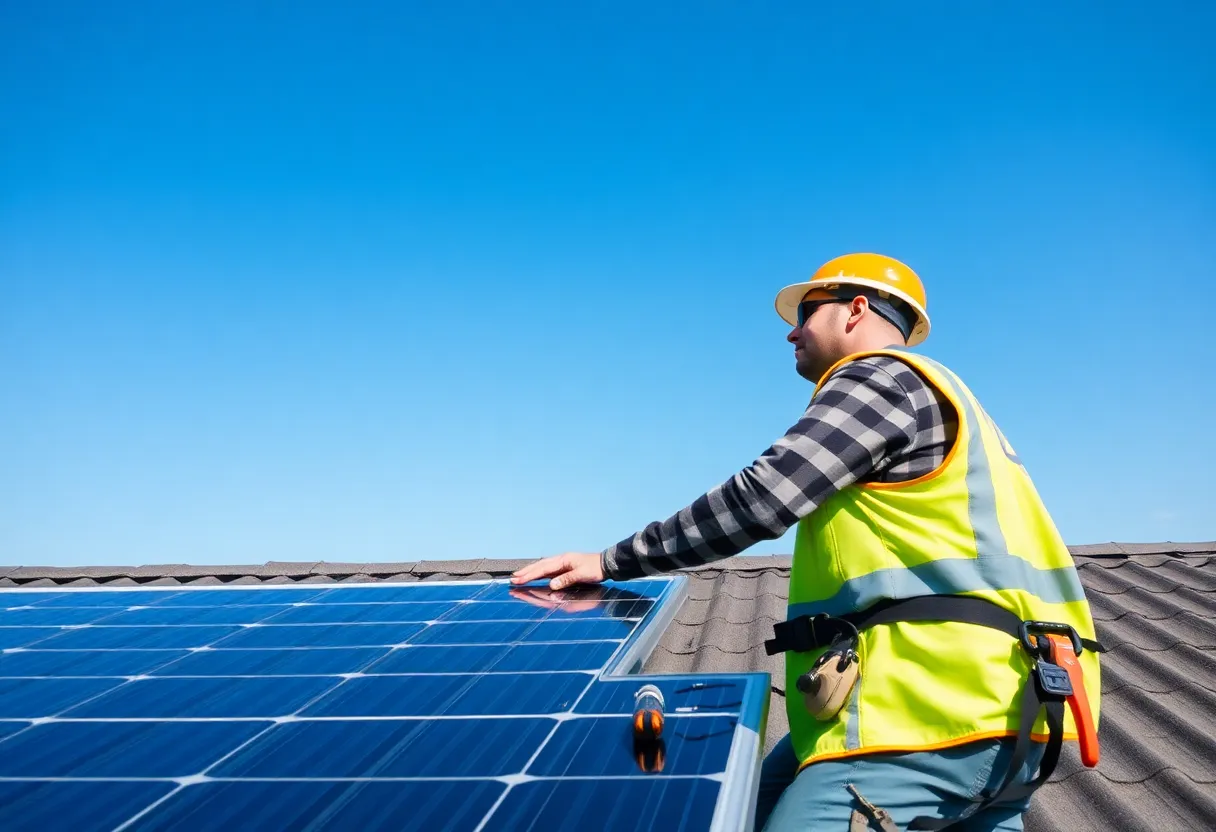

A skilled technician safely installing solar panels on a roof, ensuring all safety protocols are followed.
Article Sponsored by:
Mays Contracting is more than just a roofing company; it’s a family legacy built on trust and quality. Founded in 1979, we’ve been serving the community for over four decades. Our story began with a simple vision: to provide exceptional roofing services for both residential and commercial properties. This vision has guided us ever since, as we’ve grown from a small, family-run operation to a trusted name in the industry.
Installing solar panels on your roof can significantly reduce energy costs and promote environmental sustainability. However, careful planning and adherence to safety protocols are vital. This article outlines essential considerations and steps to safely install solar panels on your rooftop.
The first step is to evaluate the structural integrity of your roof. Inspect for signs of damage or wear, such as cracked shingles or sagging. A compromised roof may not support the weight of solar panels, which can range from 40 to 50 pounds each. To ensure safety and longevity, consider conducting a professional inspection.
Different roof types require specific installation methods. Flat roofs often utilize ballast systems, while pitched roofs may need mounting brackets. Understanding your roof type will inform selection of materials and techniques, optimizing both safety and performance.
Before commencing installation, familiarize yourself with local building codes and zoning laws. Some regions require permits for solar panel installation. Researching these rules early can prevent costly delays or potential fines.
Creating a comprehensive design layout is crucial for safe installation. This should include the configuration of solar panels, placement of electrical components, and ensuring adequate spacing for maintenance access. Follow manufacturer guidelines and best practices for spacing to optimize solar performance while ensuring safety.
Select high-quality solar panels and mounting hardware from reputable manufacturers. Inferior materials can lead to system failure, increased maintenance costs, or potential safety hazards. Invest in durable materials that can withstand local weather conditions.
Safety gear is essential. Ensure all personnel wear helmets, gloves, and non-slip footwear during installation. Additionally, consider employing harnesses and safety lines when working on steep roofs to prevent falls.
If you lack roofing experience, it might be prudent to hire experienced professionals for installation. Their expertise minimizes the risk of accidents and structural damage. Their services often include securing the necessary permits, inspections, and ensuring compliance with regulations.
Connecting solar panels involves working with electricity, which can pose severe risks. Follow all electrical code requirements to ensure safe and efficient connections. If you are unsure about electrical work, enlist a certified electrician.
Before starting installation, ensure you have all necessary tools and materials on site. This typically includes:
Itemize each component to avoid disruptions during the installation process.
Start by clearing the area where the panels will be installed. Remove debris, equipment, and any obstructions. Ensure the surface is clean and dry to facilitate proper sealing and mounting of panels.
Begin installation by attaching mounting brackets to the roof. For pitched roofs, place brackets beneath roofing shingles to prevent leaks. Ensure brackets are secured tightly using lag bolts and weatherproof seals. This step is critical for stabilizing the entire solar panel system.
Once the brackets are in place, positioning the solar panels becomes next. Align the panels with the mounting brackets and secure them using the provided fasteners. Ensure each panel is level and properly aligned to maximize solar exposure throughout the day.
Next, focus on the electrical connections. Connect the solar panels to the inverter in accordance with the manufacturer’s instructions. Ensure that all wiring is secured and protected from the elements. Double-check connections to safeguard against short circuits and energy loss.
After the installation, conduct a thorough inspection of the entire system. Check for secure mounts, proper wiring, and any potential obstructions that might affect the performance. This final assessment is crucial to ensure safety and efficiency.
After installation, it is essential to routinely monitor the solar panel system’s performance. Many systems offer digital monitoring options to track energy production. Identify potential issues early to avoid costly repairs later.
Routine maintenance can extend the lifespan of your solar panels. Regularly check for dirt, debris, or any signs of wear. Cleaning panels and inspecting connections will help ensure optimal energy efficiency and performance.
Research financial incentives available for solar energy adoption. Many regions offer tax breaks, rebates, or financing options for solar panel installation. These programs can significantly reduce the overall cost and encourage the transition to renewable energy.
Installing solar panels on your roof is a valuable investment that requires careful planning and execution. By understanding your roof’s condition, following safety protocols, and considering local regulations, you can effectively install a solar panel system that is both efficient and safe.
Ultimately, the move to solar energy not only benefits your wallet but also contributes positively to the environment.

Quality Roof Construction and Repair in Lexington, Richland, Newberry and Laurens Counties for over 40 Years.
News Summary In a significant policy shift, the Trump administration is set to revoke the…
News Summary On April 5, thousands are expected to protest against President Trump at the…
News Summary Farmers across the nation are relieved as the USDA announces the release of…
News Summary The Trump administration has replaced Gen. Timothy Haugh, the NSA director, and his…
News Summary President Trump has initiated a significant trade war with new tariffs, introducing a…
News Summary The Irmo community mourns the loss of Orris Bickley, a long-time resident cherished…